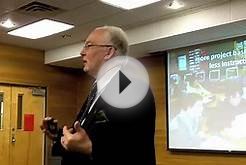Campus Schools
Search & Apply to New Jobs *
Get Your Degree!
Find schools and get information on the program that’s right for you.
Post-secondary or tertiary education, also referred to as third-stage, third level education, or higher education, is the non-compulsory educational level.
Higher education is education provided by universities, vocational universities (community colleges, liberal arts colleges, and technical colleges, etc.) and other collegial institutions that award academic degrees, such as career colleges following the completion of a school that provides secondary education, such as a high school and secondary K-12 schools.
The US education structure includes 12 years of regular schooling (K1 to K-12), preceded by a year or two of pre-school education (kinder garden), and followed by a four-stage postsecondary higher education degree system (associate, bachelor's, master's, doctorate) plus various non-degree certificates and diplomas on the way. In addition, there are special education services, adult basic and continuing education, leisure learning programs, and continuing professional education and training programs. Completion of each level or stage is a prerequisite for access to the next, and a variety of assessment and evaluation tools are used to determine learning needs, academic achievement standards, and eligibility to proceed to higher levels of education.
What kind of college do you see yourself attending? Different types of postsecondary colleges suit different types of people. Most postsecondary schools can be described as or, or .
Public institutions are state supported. Private for-profit institutions are businesses. Private not-for-profit institutions are independent - for instance, the school might have been established by a church or through local community donations rather than by the state government.
Four-year institutions offer bachelor's degrees, and some offer advanced degrees. two year institutions offer associate's degrees. Less-than-two year institutions offer training and award certificates of completion.
Look at these descriptions to help you see where you fit.
Colleges:
A grants bachelor's degrees (Bachelor of Arts; Bachelor of Science). Some colleges also award master's degrees, and some also offer a two year Associate of Arts (AA) degree. Colleges can be specialized (for example, in nursing) or they can offer a broad curriculum, like the liberal arts which focus on the humanities, social sciences, and sciences. Classes tend to be smaller than those in universities. This provides students with more personal attention and better access to the faculty.
Universities:
A grants bachelor's and master's degrees, and sometimes usually include a liberal arts college, some professional schools or colleges, and graduate programs such as a law school or medical school. Universities tend to be larger than colleges, focus more on scholarly or scientific research, and might have larger class sizes. This means they can offer the two year and four-year degrees as well as graduate degrees in advanced studies beyond four years. Universities offer a huge course selection and may have extensive resources. Class size varies, depending on the size of the university, the subject area, and the course level. University professors are usually involved in research. Graduate students, rather than professors, teach some of the classes. (These graduate students are called Teaching Assistants or TAs.)
Community colleges:
A granting associate's degrees in two year liberal arts program and sometimes certificates in particular technical (career-related) subjects. Typically community college are open admissions. They are open to those 18 years of age or older. However, to be placed into a major, the individual must have a high school diploma, GED, or be placed according to ability to benefit. Some students start their postsecondary education at a community college and then transfer to a four-year school, either because a community college tends to be cheaper than a four-year college, or because admissions standards at community colleges are often less strenuous than at four-year schools. But mostly serve people from nearby communities and offer academic courses, technical courses, and continuing education courses. Public institutions are supported by state and local revenues
Junior colleges:
Similar to a, except that a is usually a private school.
Career school, technical school, or vocational/trade school:
These terms are often used interchangeably. May be public or private, two year or less-than-two year. Study programs at these schools prepare students for specific careers and may last weeks, months, or years, depending on career requirements. At these schools, students usually receive a license, a certificate, or an associate degree. offer courses that are designed to prepare students for specific careers, from welding to cosmetology to medical imaging, etc. The difference between technical schools and trade schools is that technical schools teach the science behind the occupation, while trade schools focus on hands-on application of skills needed to do the job.
Public vs. Private offer a wide range of degrees and certificates up to the doctoral level, as well as professional degrees such as law and medicine. These schools are diverse in character, academic emphasis, and origins. Some schools have a religious affiliation; others are secular. Private schools may be profit or non-profit institutions. Typically, private schools give weight to personal characteristics and activities in addition to considering GPA and test scores. While many private schools are considerably more expensive than comparable state institutions, they also tend to offer more generous financial aid packages. Many students have found the actual out-of-pocket cost to attend a private college to be less than the cost of the state schools to which they were accepted. On the one hand, public colleges are usually less expensive, particularly for in-state residents. They get most of their money from the state or local government. Check out your state's Guide to Residency. Private colleges rely on tuition, fees, endowments, and other private sources. On the other hand, private colleges are usually smaller and can offer more personalized attention (and some believe, more prestige).









